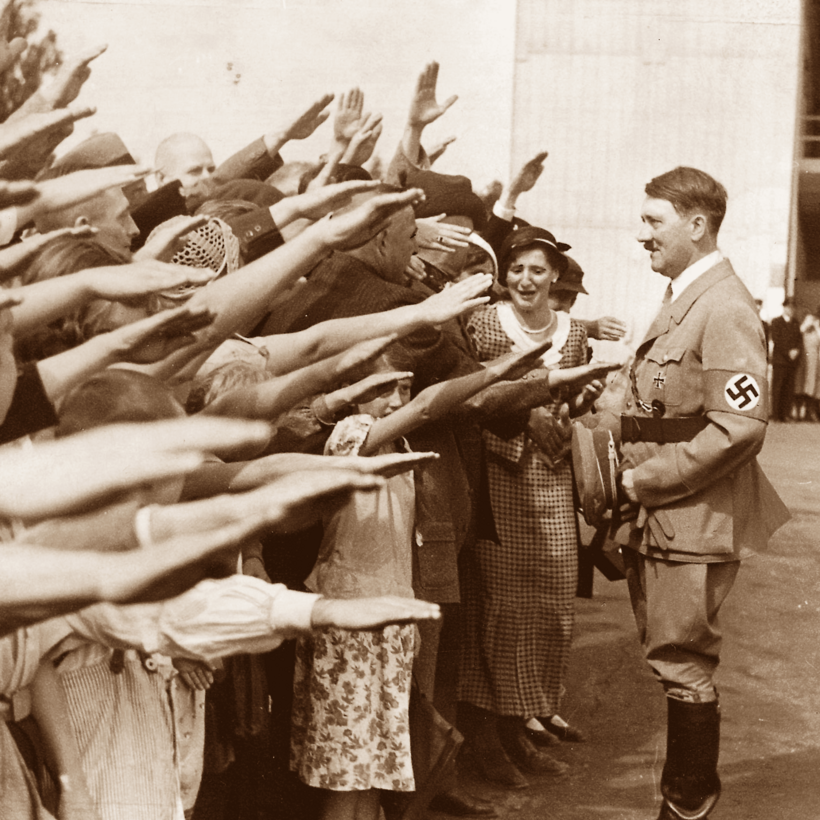On the evening of January 30, 1933, hundreds of storm troopers paraded by torchlight through Berlin to mark the appointment of Adolf Hitler as chancellor of Germany. The “jubilation,” recalled a supporter named Günter Loshe, “was spontaneous.” At long last, “a man was trying to clean up the stables.” The old, establishment politicians had failed. People said: “He is going to push reforms through and quickly.” Germany, humiliated at the end of the First World War and in the grips of the Great Depression, would revive. “There was a wish,” continued Loshe, “to place power in the hands of a man who says: ‘We will do it. That’s how it’s done.’”
So began the darkest chapter in human history. German democracy was dismantled in a matter of weeks. Dachau, the first concentration camp, opened its gates in March of 1933. A boycott of Jewish shops and businesses followed on April 1. Jews, social democrats, and other “undesirables” were thrown out of the civil service and the courts. The Nuremberg race laws, restricting German citizenship to those of “pure German blood,” were created in September of 1935. And on November 5, 1937, Hitler informed his paladins of his plan to wage a war for “living space” in Eastern Europe and crush “two hate-inspired antagonists,” Britain and France.
The story is well known, but the historian Laurence Rees—the creator of what remains the best documentary on the Third Reich, The Nazis: A Warning from History—is less interested in what happened than why it happened. Specifically, he has sought to utilize neuropsychology and behavioral and social psychology to try to understand how educated men and women could plumb the depths of depravity and barbarism.
Naturally, there are dangers in a psychological approach to history. To take a non-Nazi example: it is often claimed that Stalin’s brutal childhood helps explain the nature of his dictatorship. But while lots of children have the misfortune to suffer physical abuse (his father was an alcoholic who once kidnapped him) or disabilities (an accident left the 12-year-old Ioseb Jughashvili, as was he then known, with a withered arm), they do not all become mass murderers. Similarly, the psychological traits that led people to support the Nazis are present or can become present in most of us. What matters is the political, cultural, economic, social, and historical context.
Fortunately, Rees understands this, and The Nazi Mind is very much a history book peppered with psychology, rather than a psychology book seasoned by history. It is also extremely timely. Although modern comparisons with the Third Reich are typically odious or ridiculous (sometimes both), the increasing support today for authoritarian and extremist regimes across the world makes an understanding of the 1930s and 1940s more important than ever.
Rees divides his book into “Twelve Warnings,” or red flags to look for in governments and societies today. Although some seem mercifully historic, the majority are disturbingly relevant. These include “Spreading Conspiracy Theories,” “Using Them and Us,” “Attacking Human Rights,” and “Eliminating Resistance.”
As Rees observes: Nazism “thrived on conspiracy theories.” Among the most important was that Germany had not been defeated on the battlefield during the First World War but on the homefront, “betrayed” by German Jews, Communists, and social democrats—the “stab-in-the-back” myth. Conspiracy theorists are “looking for someone to blame,” notes Rees, quoting social psychologist Karen Douglas. The idea that “there are these people pulling the strings behind the scenes” helps them deal with their “feelings of powerlessness and disillusionment.”
A natural corollary to the use of conspiracy theories was the idea that truth was transient, changing according to the ideas and circumstances of the time. “Any thought is right,” wrote the future Nazi minister of propaganda, Joseph Goebbels, in 1923. “You must only be able to prove it convincingly.... The thought that has the strongest advocate gains acceptance.”
The latter chapters of Rees’s book, covering the Einsatzgruppen (SS-operated death squads) and the Holocaust, make for grim reading. The “Them and Us” theory, which separated the “Master Race” from the “Untermensch” (a German word meaning “subhuman,” used by the Nazi Party to refer to Jews, Roma, and Slavs), reached its apotheosis on the killing fields of Eastern Europe. “I aimed calmly and shot with confidence at the women, children and numerous babies,” wrote a German officer charged with organizing a ghetto clearance. “The babies flew in great arcs and we shot them to pieces in the air.”
Although some were sadists, most of those that committed murder in the name of “racial purity” were not psychopaths. In Einsatzgruppe A, 11 of the 17 most senior leaders were lawyers; 9 held academic doctorates. These were men (and it was mainly, though not exclusively, men) who, in other circumstances, could have led quite innocent lives and should have been capable of independent thought. But the perversion of truth, the elimination of pluralism, the ravages of war, and the triumph of nationalist authoritarianism caused them to commit atrocities without question.
The Nazis are a warning for all time—but particularly now.
Tim Bouverie is the author of Appeasement: Chamberlain, Hitler, Churchill, and the Road to War and Allies at War: How the Struggles Between the Allied Powers Shaped the War and the World


